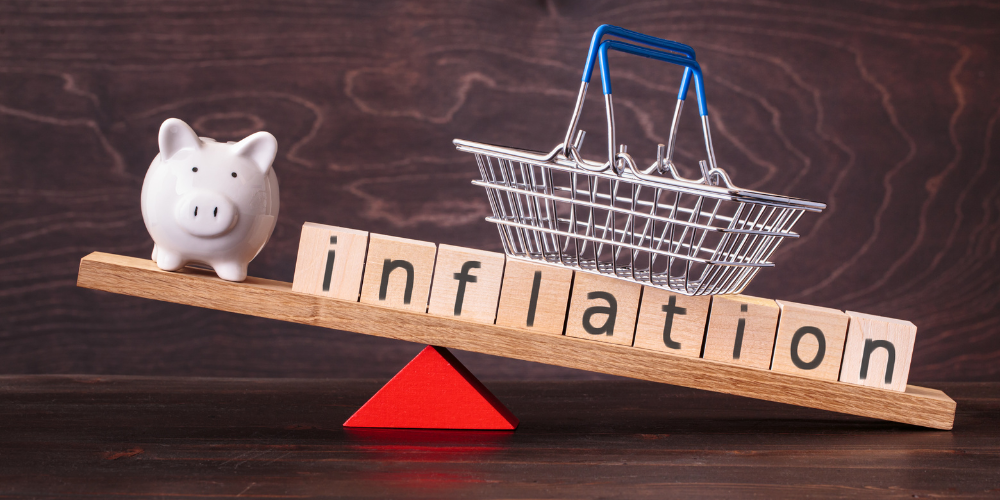Inflation, often called the “silent thief,” is an economic phenomenon that gradually erodes the purchasing power of your hard-earned money. While we may readily notice the rising prices of goods and services, the subtle impact of inflation on our savings can often go unnoticed until it’s too late. In this blog, we will delve into the concept of inflation, its actual cost beyond rising prices, and explore strategies to combat its effects on your financial well-being.
Understanding Inflation
Inflation is the sustained increase in the general price range of services and goods in an economy over a period of time. It means that a currency unit buys fewer goods and services than it did previously. For instance, if the inflation rate is 3%, a basket full of goods that cost $100 today will cost $103 next year.
There are several causes of inflation, including:
- Demand-pull inflation: Demand-pull inflation arises when the demand for goods and services outstrips the supply, leading to an increase in prices.
- Cost-push inflation: Cost-push inflation arises when the cost of production increases, such as due to rising wages or raw material costs, forcing businesses to raise prices to maintain profit margins.
- Built-in inflation: Built-in inflation arises when workers request higher wages to comply with rising prices, leading to a wage-price spiral.
- Monetary inflation: Monetary inflation occurs when the central bank raises the money supply faster than the economy’s growth. It leads to excess money chasing the same amount of services and goods, driving up prices.
While a moderate level of inflation is considered normal and even healthy for a growing economy, high or hyperinflation can have devastating consequences. It can erode the value of savings, reduce real wages, discourage investment, and create economic instability.
The Real Cost of Inflation: Beyond Rising Prices
The impact of inflation extends beyond the apparent rise in everyday goods and services prices. Here are some of the hidden costs of inflation:
- Reduced purchasing power: The most direct repercussion of inflation is the erosion of your purchasing power. It means that your savings will buy less in the future than they do today. For instance, if you have $10,000 in savings and the inflation rate is 3%, the actual value of your savings will decrease to $9,700 after one year.
- Loss of interest income: If the interest rate on your savings account is less than the inflation rate, you are effectively losing money in real terms. It is because the interest you earn is not enough to offset the loss of purchasing power due to inflation.
- Increased borrowing costs: Inflation could lead to an increase in interest rates on loans, making it more expensive to borrow money. It can sway your ability to buy a house or car or finance other major purchases.
- Uncertainty and risk: High inflation can create uncertainty and risk in the economy, making it complex and troublesome for individuals and businesses to plan for the future. It can lead to lower investment, slower economic growth, and job losses.
- Social unrest: In extreme cases, high inflation can result in political instability and social unrest as people struggle to cope with the rising cost of living.
Strategies to Combat Inflation
While inflation is a natural part of the economic cycle, there are strategies you can employ to protect your savings and investments from its erosive effects.
1. Investing in an Inflationary Environment
- Equities: Stocks have historically outperformed inflation over the long term. Investing in companies with solid fundamentals and pricing power can help you stay ahead of inflation.
- Real estate: Real estate investments may serve as a hedge against inflation, as the value of property and rental income tend to climb with inflation.
- Commodities: Commodities like gold, oil and silver can act as a hedge against inflation, as their prices tend to increase during inflationary periods.
- Inflation-protected securities: Inflation-protected securities are government bonds that offer protection against inflation. Their principal and interest payments are adjusted for inflation, ensuring your investment keeps abreast of rising prices.
2. High-Yield Savings Accounts
While traditional savings accounts may not offer interest rates that keep pace with inflation, high-yield savings accounts can be a valuable tool for preserving your purchasing power in the short term. These accounts typically offer increased interest rates than traditional savings accounts, helping you earn a better return on your savings. However, comparing interest rates and fees is crucial before choosing a high-yield savings account.
3. The Role of Diversification
Diversification is a vital principle of investing that involves reducing risk by diversifying your investments across different asset categories. By diversifying your portfolio, you can weaken the impact of inflation on your overall investments. If one asset class underperforms due to inflation, others may perform well and offset the losses.
The Psychology of Inflation: Managing Anxiety and Making Informed Decisions
Inflation can create anxiety and uncertainty, leading to impulsive financial decisions. It’s essential to manage your emotions and make wise choices based on your risk tolerance and financial goals.
Here are some tips for managing the psychological impact of inflation:
- Stay informed: Stay up to date on the latest economic news and inflation trends. It will help you make informed decisions about your savings and investments.
- Focus on the long term: Don’t let short-term market fluctuations derail your long-term financial goals. Stay invested and avoid making rash and impulsive decisions based on fear or greed.
- Seek professional advice: Confer with a financial advisor if you need help protecting your savings from inflation. They can help you create a customised investment plan that best aligns with your risk tolerance and financial goals.
Conclusion
Inflation is an unavoidable economic reality, but it doesn’t have to erode your financial well-being. By understanding the impact of inflation, exploring various investment strategies, and making informed decisions, you can safeguard your savings and achieve your financial goals.
Remember, the crucial aspect is to stay informed, remain disciplined, and seek professional advice when needed. By taking proactive steps to combat inflation, you can ensure that your hard-earned money retains its value and continues to work for you in the long run.
Disclaimer
The information in this blog is common knowledge and does not constitute financial advice. Conducting research and conferring with a qualified financial advisor before executing any investment decisions is essential.


